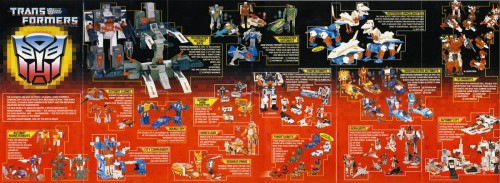
Update 07/19/2022
Just 3 months after my previous update I felt like there was already a “long overdued” further update. That is how quickly the field is evolving. In this recent update I have added the new class of text to image transformers, all the way from diffusion models to DALL-E2, and Imagen. Another class of Transformer models I added are those that allow to use transformers to model an arbitrary agent with RL applications such as playing Atari or controling a robotic arm. Those include Trajectory Transformers, Decision Transformers, and Deepmind’s GATO. I have also included the latest open source BLOOM model. The full list of newcomers to the catalog: BLOOM, CLIP, DALL-E2, Decision and Trajectory Transformers, Flamingo, Gato, DQ-BART, GLaM, GLIDE, GC-ViT, Imagen, LAMDA, Minerva, OPT, PaLM, and Switch.
Another novelty in this edition of the catalog is that I have added the “lab” behind each of these Transformer models. I realized during my usage of the catalog that associating the original lab where the model was developed made a lot of sense and was not always obvious. Finally, I added a Catalog Index to facilitate browsing. Enjoy!
Catalog Index
Click on the list to access a Tranformer model directly, or keep reading below for more context and explanations.
Why this post
I have a terrible memory for names. In the past few years we have seen the meteoric appearance of dozens of models of the Transformer family, all of which have funny, but not self-explanatory, names. The goal of this post is to offer a short and simple catalog and classification of the most popular Transformer models. In other words, I needed a Transformers cheat-sheet and couldn’t find a good enough one online, so I thought I’d write my own. I hope it can be useful to you too.
What are Transformers
Transformers are a class of deep learning models that are defined by some architectural traits. They were first introduced in the now famous Attention is All you Need paper by Google researchers in 2017 (the paper has accumulated a whooping 38k citations in only 5 years) and associated blog post.
The Transformer architecture is a specific instance of the encoder-decoder models that had become popular just over the 2–3 years prior. Up until that point however, attention was just one of the mechanisms used by these models, which were mostly based on LSTM (Long Short Term Memory) and other RNN (Recurrent Neural Networks) variations. The key insight of the Transformers paper was that, as the title implies, attention could be used as the only mechanism to derive dependencies between input and output.
It is beyond the scope of this blog to go into all the details of the Transformer architecture. For that, I will refer you to the original paper above or to the wonderful The Illustrated Transformer post. That being said, we will briefly describe the most important aspects since we will be referring to them in the catalog below. Let’s start with the basic architectural diagram from the original paper, and describe some of the components.
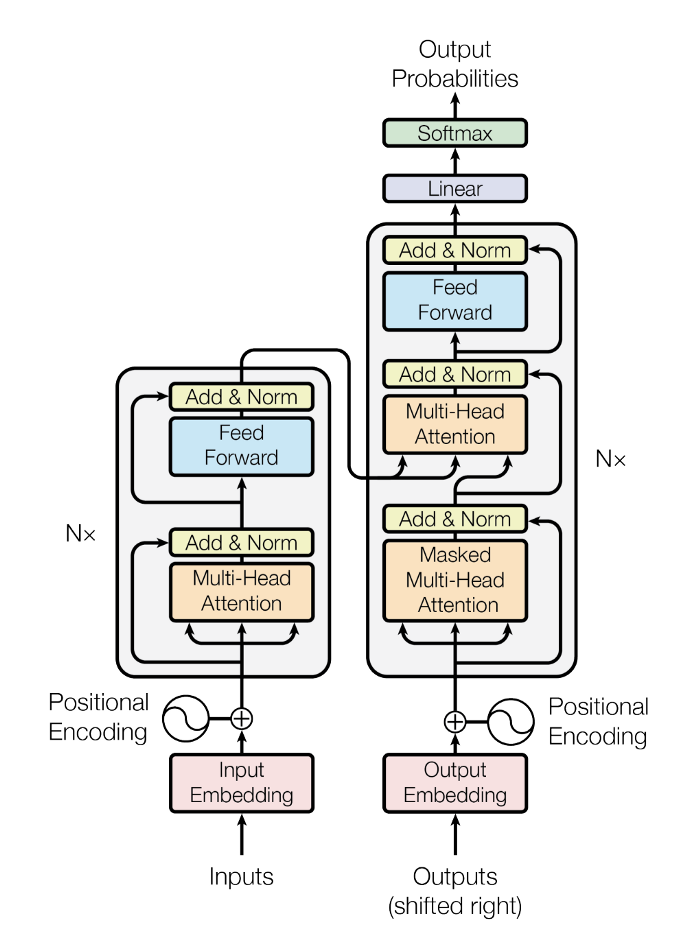
Encoder/Decoder architecture
A generic encoder/decoder architecture is made up of two models. The encoder takes the input and encodes it into a fixed-length vector. The decoder takes that vector and decodes it into the output sequence. The encoder and decoder are jointly trained to minimize the conditional log-likelihood. Once trained the encoder/decoder can generate an output given an input sequence or can score a pair of input/output sequences.
In the case of the original Transformer architecture, both encoder and decoder had 6 identical layers. In each of those 6 layers the Encoder has two sub layers: a multi-head attention layer, and a simple feed forward network. Each sublayer has a residual connection and a layer normalization. The output size of the Encoder is 512. The Decoder adds a third sublayer, which is another multi-head attention layer over the output of the Encoder. Besides, the other multi-head layer in the decoder is masked to prevent attention to subsequent positions.
Attention
It is clear from the description above that the only “exotic” elements of the model architecture are the multi-headed attention, but, as described above, that is where the whole power of the model lies! So, what is attention anyway? An attention function is a mapping between a query and a set of key-value pairs to an output. The output is computed as a weighted sum of the values, where the weight assigned to each value is computed by a compatibility function of the query with the corresponding key. Transformers use multi-headed attention, which is a parallel computation of a specific attention function called scaled dot-product attention. I will refer you again to the The Illustrated Transformer post for many more details on how the attention mechanism works, but will reproduce the diagram from the original paper here so you get the main idea
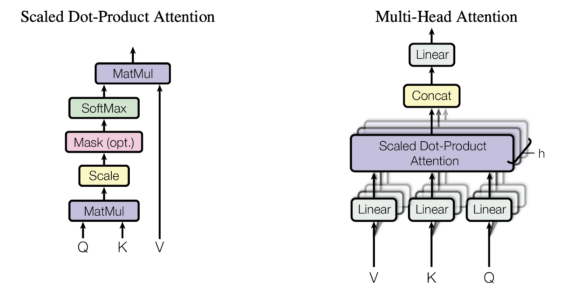
There are several advantages of attention layers over recurrent and convolutional networks, the two most important being their lower computational complexity and their higher connectivity, especially useful for learning long-term dependencies in sequences.
What are Transformers used for and why are they so popular
The original transformer was designed for language translation, particularly from English to German. But, already the original paper showed that the architecture generalized well to other language tasks. This particular trend became quickly noticed by the research community. Over the next few months most of the leaderboards for any language-related ML task became completely dominated by some version of the transformer architecture (see for example the well known SQUAD leaderboard for question answer where all models at the top are ensembles of Transformers).
One of the key reasons Transformers were able to so quickly take over most NLP leaderboards is their ability to quickly adapt to other tasks, a.k.a. Transfer learning. Pretrained Transformer models can adapt extremely easily and quickly to tasks they have not been trained on, and that has huge advantages. As an ML practitioner, you no longer need to train a large model on a huge dataset. All you need to do is re-use the pretrained model on your task, maybe just slightly adapting it with a much smaller data set. A specific technique used to adapt pretrained models to a different task is the so-called fine tuning.
It turns out that the capability of Transformers to adapt to other tasks is so great, that, while they were initially developed for language related tasks, they quickly became useful for other tasks ranging from vision or audio and music applications all the way to playing chess or doing math!
Of course all these applications would have not been possible if it wasn’t because of the myriad of tools that made them readily available to anyone that could write a few lines of code. Not only were Transformers quickly integrated into the main AI frameworks (namely Pytorch and TF), but they even enabled the creation of an entire company around them. Huggingface, a startup that has raised over $60M to this day, is almost entirely built around the idea of commercializing their open source Transformers library.
Last but not least, I would be remiss if I did not mention the impact of GPT-3 on the popularization of Transformers. GPT-3 is a Transformer model introduced by OpenAI in May 2020 as a follow up to their earlier GPT and GPT-2. The company made a big splash by introducing the model in a preprint in which they claimed that the model was so powerful that they were not in a position to release it to the world. Since then, the model has not only been released, but also commercialized through a very large partnership between OpenAI and Microsoft. GPT-3 powers over 300 different applications, and is the foundation for OpenAI’s commercial strategy (which is a lot to say for a company that has received over $1B in funding).
The Transformers catalog
So hopefully by now you understand what Transformer models are, and why they are so popular and impactful. In this section I will introduce a catalog of the most important Transformer models that have been developed to this day. I will categorize each model according to the following properties: Pretraining Architecture, Pretraining Task, Compression, Application, Year, and Number of Parameters. Let’s briefly define each of those:
Pretraining Architecture
We described the Transformer architecture as being made up of an Encoder and a Decoder, and that is true for the original Transformer. However, since then, different advances have been made that have revealed that in some cases it is beneficial to use only the encoder, only the decoder, or both.
Encoder Pretraining
These models, which are also called bi-directional or auto-encoding, only use the encoder during pretraining, which is usually accomplished by masking words in the input sentence and training the model to reconstruct. At each stage during pretraining, attention layers can access all the input words. This family of models are most useful for tasks that require understanding complete sentences such as sentence classification or extractive question answering.
Decoder Pretraining
Decoder models, often called auto-regressive, use only the decoder during a pretraining that is usually designed so the model is forced to predict the next word. The attention layers can only access the words positioned before a given word in the sentence. They are best suited for tasks involving text generation.
Transformer (Encoder-Decoder) Pretraining
Encoder-decoder models, also called sequence-to-sequence, use both parts of the Transformer architecture. Attention layers of the encoder can access all the words in the input, while those of the decoder can only access the words positioned before a given word in the input. The pretraining can be done using the objectives of encoder or decoder models, but usually involves something a bit more complex. These models are best suited for tasks revolving around generating new sentences depending on a given input, such as summarization, translation, or generative question answering.
Pretraining Task
When training a model we need to define a task for the model to learn on. Some of the typical tasks, such as predicting the next word or learning to reconstruct masked words were already mentioned above. “Pre-trained Models for Natural Language Processing: A Survey” includes a pretty comprehensive taxonomy of pretraining tasks, all of which can be considered self-supervised:
- Language Modeling (LM): Predict next token (in the case of unidirectional LM) or previous and next token (in the case of bidirectional LM)
- Masked Language Modeling (MLM): mask out some tokens from the input sentences and then trains the model to predict the masked tokens by the rest of the tokens
- Permuted Language Modeling (PLM): same as LM but on a random permutation of input sequences. A permutation is randomly sampled from all possible permutations. Then some of the tokens are chosen as the target, and the model is trained to predict these targets.
- Denoising Autoencoder (DAE): take a partially corrupted input (e.g. Randomly sampling tokens from the input and replacing them with [MASK] elements. randomly deleting tokens from the input, or shuffling sentences in random order) and aim to recover the original undistorted input.
- Contrastive Learning (CTL): A score function for text pairs is learned by assuming some observed pairs of text that are more semantically similar than randomly sampled text. It includes: Deep InfoMax (DIM): maximize mutual information between an image representation and local regions of the image; Replaced Token Detection (RTD): predict whether a token is replaced given its surroundings; Next Sentence Prediction (NSP): train the model to distinguish whether two input sentences are continuous segments from the training corpus; and Sentence Order Prediction (SOP): Similar to NSP, but uses two consecutive segments as positive examples, and the same segments but with their order swapped as negative examples
Application
Here we will note what are the main practical applications of the Transformer model. Most of these applications will be in the language domain (e.g. question answering, sentiment analysis, or entity recognition). However, as mentioned before, some Transformer models have also found applications well beyond NLP and are also included in the catalog.
Catalog table
Note: For all the models available in Huggingface, I decided to directly link to the page in the documentation since they do a fantastic job of offering a consistent format and links to everything else you might need, including the original papers. Only a few of the models (e.g. GPT3) are not included in Huggingface.

You can access the original table here for easier browsing across the different model features. If you prefer to read the full list see below.
Family Tree
The diagram below is just a simple view that should highlight the different families of transformers and how they relate to each other.
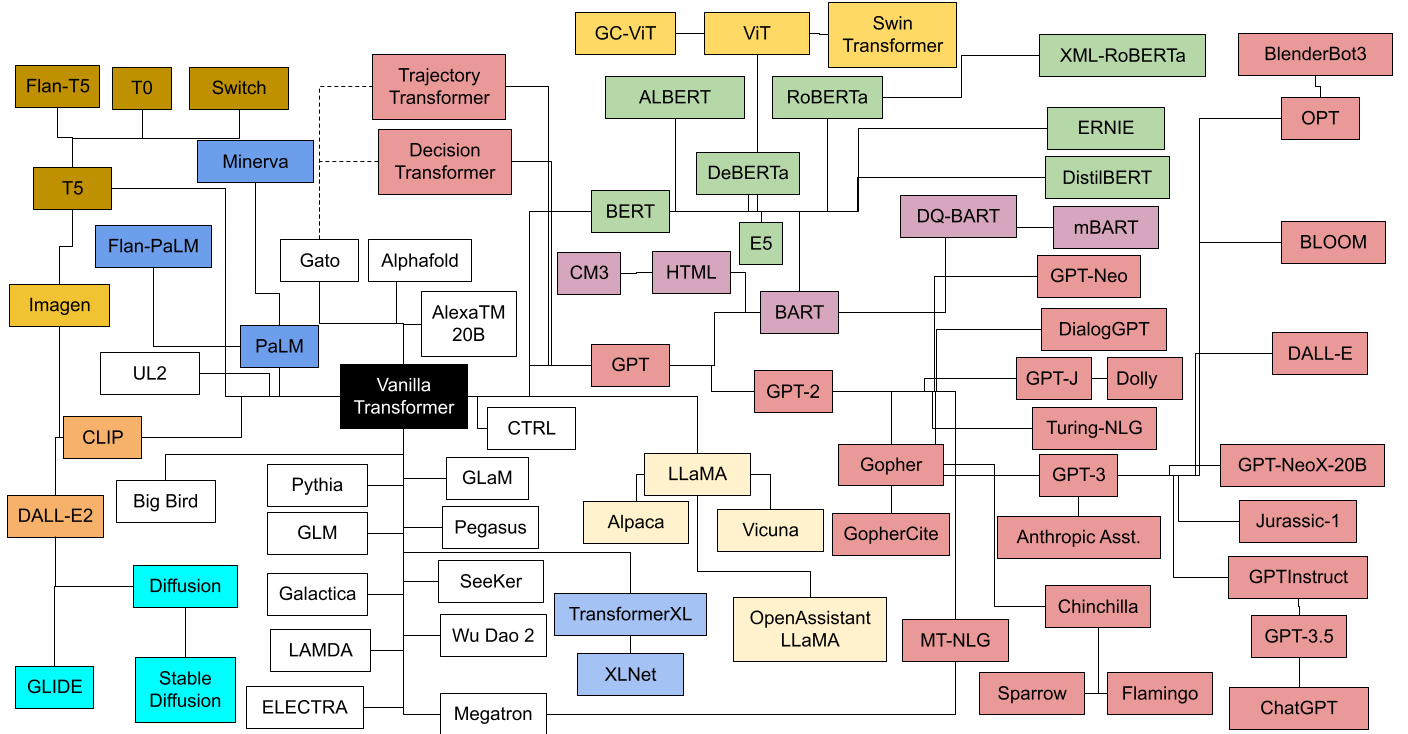
Chronological timeline
Another interesting perspective is this chronological timeline of the main Transformer models borrowed from Huggingface here.
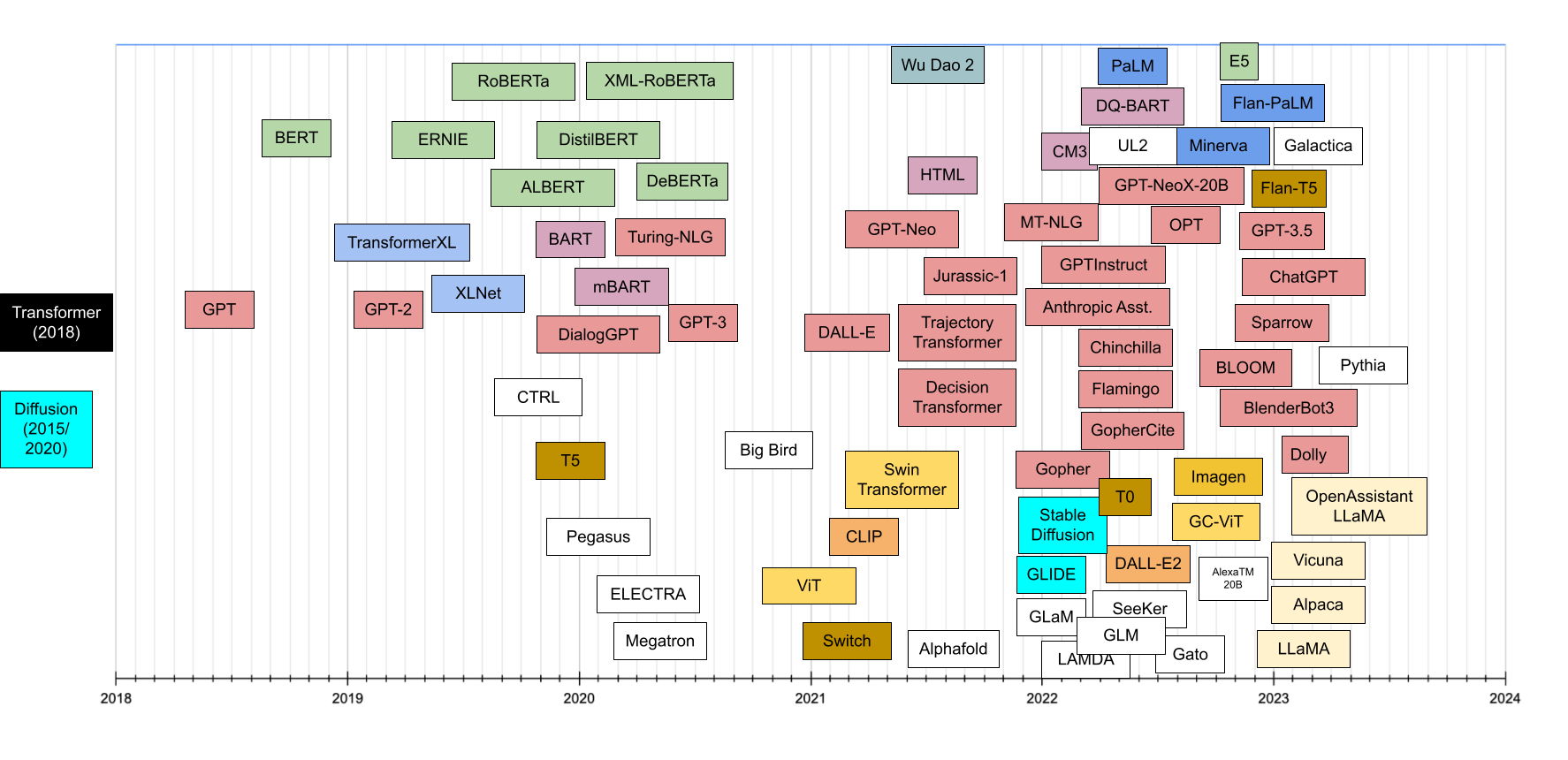
Catalog List
Finally, here is a list view that might be easier to follow along in some cases:
Family: BERT
Pretraining Architecture: Encoder
Pretraining Task: MLM/NSP
Extension: Compressed version of BERT using parameter sharing, which is much more efficient given the same number of parameters
Application: Same as BERT
Date (of first known publication): 09/2019
Num. Params: Base = 12M, Large = 18M, XLarge = 60M
Corpus: Same as BERT
Lab: Google
Family: BERT for encoder, GPT for Decoder
Pretraining Architecture: Encoder/Decoder
Pretraining Task: DAE
Extension: It can be seen as a generalization of BERT and GPT in that it combines ideas from both in the encoder and decoder
Application: Mostly text generation but also some text understanding tasks
Date (of first known publication): 10/2019
Num. Params: 10% more than BERT
Corpus: Same as RoBERTa (160Gb of news, books, stories,
and web text)
Lab: Facebook
Family: BERT
Pretraining Architecture: Encoder
Pretraining Task: MLM/NSP
Extension:
Application: General Language Understanding and Question Answering. Many other language applications followed
Date (of first known publication): 10/2018
Num. Params: Base = 110M, Large = 340M
Corpus: Toronto Book Corpus and Wikipedia (3.3B Tokens)
Lab: Google
Family:
Pretraining Architecture: Encoder AND Encoder/Decoder (BigBird is mostly a way to implement sparse attention that is implemented both in an Encoder-only as wells as Encoder/Decoder architecture)
Pretraining Task: MLM
Extension: Big Bird can extend other architectures such as BERT, Pegasus, or RoBERTa by using a sparse attention mechanism that elminates the quadratic dependency thus making it more suitable for longer sequences
Application: Particularly well suited for longer sequences, not only in text but also e.g. in genomics
Date (of first known publication): 07/2020
Num. Params: Depends on the overall architecture
Corpus: Books, CC-News, Stories and Wikipedia
Lab: Google
Family: GPT
Pretraining Architecture: Decoder
Pretraining Task: LM
Extension: * Main difference to GPT-3 is that it uses full attention instead of sparse attention*
Application: Same as GPT-3
Date (of first known publication): 07/2022
Num. Params: 176B
Corpus: 366B tokens (1.5 TB of text data) multilingual dataset
Lab: Big Science/Huggingface
Family: GPT
Pretraining Architecture: Decoder
Pretraining Task: LM
Extension: Same as Gopher but with optimizations to reduce model size and therefore training/inference time with equal or superior performance
Application: Same as Gopher/GPT3
Date (of first known publication): 03/2022
Num. Params: 70B
Corpus: Massive Text
Lab: Deepmind
Family: CLIP (Also using Resnet, ViT, and vanilla transformer for text)
Pretraining Architecture: Encoder
Pretraining Task: predict which of the N × N possible (image, text) pairings across a batch actually occurred
Extension: * Combines Resnet and ViT for the visual encoding with Transformer for the Textual encoder*
Application: Image/object classification
Date (of first known publication): 02/2021
Num. Params: ?
Corpus: WIT (WebImageText) - 400 million text,image pairs
Lab: OpenAI
Family:
Pretraining Architecture: Decoder
Pretraining Task:
Extension: model can generate text conditioned on control codes that specify domain, style,
topics, dates, entities, relationships between entities, plot points, and task-related behavior
Application: Controllable text generation
Date (of first known publication): 09/2019
Num. Params: 1.63B
Corpus: 140 GB of text including: Wikipedia (En, De, Es, Fr), Project Gutenberg, 45 subreddits, OpenWebText2, Amazon Reviews, Europarl and UN data from WMT, question-answer pairs from ELI5, and the MRQA shared task3, which includes the Stanford Question Answering Dataset, NewsQA, TriviaQA, SearchQA, HotpotQA , and Natural Questions
Lab: Salesforce
Family: GPT
Pretraining Architecture: Decoder
Pretraining Task: Caption prediction
Extension: * A differential variational auto-encoder is used to learn the visual codebook. The transformer is a variation of GPT-3*
Application: Text to image
Date (of first known publication): 01/2021
Num. Params: 12B
Corpus: 250 million text-images pairs from the internet
Lab: OpenAI
Family: CLIP, GLIDE
Pretraining Architecture: Encoder/Decoder
Pretraining Task: Caption prediction
Extension: Combines CLIP encoder and Diffusion decoder similar to GLIDE
Application: Text to image
Date (of first known publication): 04/2022
Num. Params: 3.5B
Corpus: Combination of the DALL-E and CLIP datasets
Lab: OpenAI
Family: GPT, Control Transformers” (not per se a family, but grouping here those transformers that try to model more general control, RL-like, tasks)
Pretraining Architecture: Decoder
Pretraining Task: Next action prediction
Extension: Decision transformers use a GPT architecture and extend it by encoding trajectories in a way that they can be learned by an auto-regressive task
Application: General RL (reinforcement learning tasks)
Date (of first known publication): 06/2021
Num. Params: Same as GPT
Corpus: Different corpus for different experiments
Lab: Google/UC Berkeley/Facebook
Family: GPT
Pretraining Architecture: Decoder
Pretraining Task: LM
Extension: GPT-2 architecture trained on dialog data
Application: Text generation in dialog settings
Date (of first known publication): 10/2019
Num. Params: 1.5B
Corpus: 140M Reddit conversations
Lab: Microsoft
Family: BERT
Pretraining Architecture: Encoder
Pretraining Task: MLM/NSP
Extension: Compressed version of BERT using distillation, which is much more efficient given the same number of parameters
Application: Same as BERT
Date (of first known publication): 10/2019
Num. Params: 66M
Corpus: Same as BERT
Lab: Huggingface
Family: BART
Pretraining Architecture: Encoder/Decoder
Pretraining Task: DAE
Extension: Adds quantization and distillation to a BART model to improve performance and model size
Application: Text generation and understanding
Date (of first known publication): 03/2022
Num. Params: Up to 30x reduction in parameters compared to standard BART
Corpus: CNN/DM, XSUM, ELI5, WMT16 En-Ro (~1M tokens)
Lab: Amazon
Family:
Pretraining Architecture: Encoder
Pretraining Task: RTD
Extension:
Application: Same as BERT
Date (of first known publication): 03/2020
Num. Params: Base = 110M, Large = 330M
Corpus: Same as BERT except for Large with is same as XLNet
Lab: Stanford/Google
Family: BERT
Pretraining Architecture: Encoder
Pretraining Task: MLM
Extension: Uses BERT for Encoder architecture, but stacks and aggregates two of them for text and entities. This architecture could be understood as BERT for text + knowledge graphs
Application: Knowledge intensive related tasks that might benefit from knowledge graphs or entities such as entity recognition
Date (of first known publication): 05/2019
Num. Params: 114M
Corpus: English Wikipedia + Wikidata for entitites (note that they initialize model to original BERT parameter values
Lab: Various Chinese institutions
Family: Chinchilla
Pretraining Architecture: Decoder
Pretraining Task: Log likelihood of text given some visual input
Extension: It uses a frozen textual language model (like Chinchilla) conditioned on the visual representation, which is encoded from a Normalizer-Free ResNet
Application: Text to image
Date (of first known publication): 04/2022
Num. Params: 80B (largest)
Corpus: MultiModal MassiveWeb (M3W): 185 million images and 182 GB text + a number of text paired with image datasets: ALIGN + LTIP (Long Text & Image Pairs) = 312 million images, and VTP (Video & Text Pairs) = 27 million short videos (approximately 22 seconds on average)
Lab: Deepmind
Family: “Control Transformers” (not per se a family, but grouping here those transformers that try to model more general control, RL-like, tasks)
Pretraining Architecture: Decoder
Pretraining Task: MLM (where tokens are either text or agent actions)
Extension: The standard decoder-only transformer architecture is preceded by an embedding layer that can embed text and images, plus add position encodings to add spatial information when applicable.
Application: *Gato presents a generalizable agent that can be used beyond text to tasks such as playing Atari or controlling a robot arm. *
Date (of first known publication): 05/2022
Num. Params: 1.2B
Corpus: 1.5T tokens including standard text (e.g. MassiveText), vision (e.g. ALIGN), and simulation environments (e.g. ALE Atari, or RGB Stacking Real Robot)
Lab: Deepmind
Family: Transformer
Pretraining Architecture: Decoder
Pretraining Task: LM
Extension: GLaM introduces a Mixture of 64 Experts to increase parameter count and generalization properties in a somewhat standard decoder-only. Transformer architecture. Only two experts get activated at a time per token, which makes the model also more efficient in training and inference.
Application: General language modeling
Date (of first known publication): 12/2021
Num. Params: 1.2T across 64 experts, but only 96B get activated for inference
Corpus: 1.6T tokens including web pages filtered by Wikipedia and books for quality
Lab: Google
Family: Diffusion models
Pretraining Architecture: Encoder
Pretraining Task: * Caption prediction*
Extension: GLIDE can be seen as an extension of the ADM (Ablated Diffusion Model) by the same authors. However, ADM is not per se a transformer architecture although it does resemble one in some of the configurations the authors use. Given that ADM is by the same authors and was quickly followed up by GLIDE, I think it is fair to consider GLIDE as the first of its kind.
Application: Text to image
Date (of first known publication): 12/2021
Num. Params: 3.5B diffusion model (2.3B for visual encoding, 1.2B for textual) + 1.5B for model for upsampling
Corpus: Same as DALL-E
Lab: OpenAI
Family: ViT
Pretraining Architecture: Encoder
Pretraining Task: Image classification
Extension: hierarchical ViT architecture consisting of local and global self-attention modules
Application: APPLICATION
Date (of first known publication): 06/2022
Num. Params: 90M
Corpus: Imagenet-1K and other task dependent dataasets
Lab: NVidia
Family: GPT
Pretraining Architecture: Decoder
Pretraining Task: LM
Extension: Same as GPT-2 but use RSNorm instead of LayerNorm and relative positional encoding rather than absolute
Application: Mostly Language Modeling and NLU, but also extensible like GPT
Date (of first known publication): 12/2021
Num. Params: 280B
Corpus: Massive Text (2.35 billion documents, or about 10.5 TB of text including Massive Web, Books, Github, News, C4, and Wikipedia.
Lab: Deepmind
Family: GPT
Pretraining Architecture: Decoder
Pretraining Task: LM
Extension:
Application: Text generation, but adaptable to many other NLP tasks when fine tuned.
Date (of first known publication): 06/2018
Num. Params: 117M
Corpus: Unsupervised Pretraining on BookCorpus dataset. Supervised Finetuning on several task-specific datasets including SNLI, RACE, Quora…
Lab: OpenAI
Family: GPT
Pretraining Architecture: Decoder
Pretraining Task: LM
Extension: Minor extensions to the GPT architecture (e.g. layer normalization moved to the input of each sub-layer, or increased context size from 512 to 1024)
Application: Text generation, but adaptable to many other NLP tasks when fine tuned.
Date (of first known publication): 02/2019
Num. Params: 1.5B
Corpus: 8 million web pages (40 GB). 10X GPT . WebText dataset is created by crawling all links at Reddit with at least 3 Karma points.
Lab: OpenAI
Family: GPT
Pretraining Architecture: Decoder
Pretraining Task: LM
Extension: Same as GPT-2 with the only addition of alternating dense and locally banded sparse
attention patterns, inspired by the Sparse Transformer
Application: Initially text generation, but has over time been used for a large range of applications in areas such as code generation, but also image and audio generation
Date (of first known publication): 05/2020
Num. Params: 175 B
Corpus: ~ 500B tokens including CommonCrawl (410B), WebText2 (19B), Books1 (12B), Books2 (55B), and Wikipedia (3B)
Lab: OpenAI
Family: GPT
Pretraining Architecture: Decoder
Pretraining Task: LM
Extension: GPTInstruct starts off with a pretrained GPT3 model and adds reward modeling through reinforcement learning after a supervised finetuning
Application: Knowledge-intensive dialog or language tasks
Date (of first known publication): 01/2022
Num. Params: Same as GPT3
Corpus: Same as GPT3 for pretraining, but finetuned and optimized using labeler data and prompts
Lab: OpenAI
Family: GPT
Pretraining Architecture: Decoder
Pretraining Task: LM
Extension: Similar to GPT-2 but uses local attention in every other layer with a window size of 256 tokens
Application: Text generation, but adaptable to many other NLP tasks when fine tuned
Date (of first known publication): 03/2021
Num. Params: 5B, 2.7B (XL)
Corpus: Pile — 840 GB open source text dataset that combines 22 pre existing datasets
Lab: EleutherAI
Family: T5, CLIP, Diffusion models
Pretraining Architecture: T5 (or CLIP or BERT) for frozen text encoder + U-net architecture for cascaded diffusion models for text to image
Pretraining Task: image/text pair prediction
Extension: Imagen adds a few extensions to the U-net diffusion architecture (pooled embedding vector, cross attention over text embeddings, and Layer Normalizations)
Application: Text to image
Date (of first known publication): 06/2022
Num. Params: 2B
Corpus: a combination of internal datasets, with ≈ 460M image-text pairs, and the publicly available Laion dataset, with ≈ 400M image-text pairs
Lab: Google
Family: GPT
Pretraining Architecture: Decoder
Pretraining Task: LM
Extension: Very similar to GPT-3, but far more parameters and improved training efficiency mostly because of the improved tokenizer. Also, different ratio of depth to breadth
Application: Similar to GPT-3
Date (of first known publication): 09/2021
Num. Params: 178B (Jumbo), 7.5B (Large)
Corpus: 300B tokens (same as GPT-3)
Lab: AI21
Family: Transformer
Pretraining Architecture: Decoder
Pretraining Task: LM
Extension: LAMDA focuses on how to improve safety, quality, and groundeness using different fine-tuning strategies
Application: General language modeling
Date (of first known publication): 01/2022
Num. Params: 137B
Corpus: 1.56T words from public dialog data and other public web documents
Lab: Google
Family: BART
Pretraining Architecture: Encoder/Decoder
Pretraining Task: DAE
Extension:
Application: Translation
Date (of first known publication): 01/2020
Num. Params: Same as BART
Corpus: CC25 Corpus includes 25 monolingual corpuses in different languages. Largest corpuses are English (300 GB) and Russian (280GB)
Lab: Facebook
Family: GPT/BERT/T5
Pretraining Architecture: Encoder or Decorder, depending on the base model
Pretraining Task: Same as base model
Extension: Megatron is a family of models that extend previously known architectures (namely GPT-2 and BERT originally, but also T5 more recently) by introducing model parallelism primitives. In the case of BERT, the authors also replace the next sentence prediction head with sentence order prediction and use whole word n-gram masking.
Application: Same as base model
Date (of first known publication): 03/2020
Num. Params: 8.3B (GPT-like), 3.9B (BERT-like)
Corpus: Original paper uses an aggregate dataset consisting of Wikipedia), CC-Stories), RealNews, and OpenWebtext
Lab: NVidia
Family: PaLM
Pretraining Architecture: Decoder
Pretraining Task: LM
Extension: Extends PaLM by fine-tuning on the mathematical dataset
Application: Mathematical reasoning
Date (of first known publication): 06/2022
Num. Params: 540B
Corpus: * Same as PaLM + 118GB dataset of scientific papers from the arXiv preprint server and web pages that contain mathematical expressions using LaTeX, MathJax, or other mathematical typesetting formats*
Lab: Google
MT-NLG (Megatron Touring NLG)
Family: GPT
Pretraining Architecture: Decoder
Pretraining Task: LM
Extension: Uses parallelization similar to Megatron to train a LM double the size of GPT-3
Application: Language generation and others (similar to GPT-3)
Date (of first known publication): 10/2021
Num. Params: 530B
Corpus: The Pile (800GB dataset) + 2 Common Crawl snapshots
Lab: NVidia
Family: GPT-3
Pretraining Architecture: Decoder
Pretraining Task: LM
Extension: Basically same architecture as GPT-3 but with some training improvements introduced in Megatron-LM
Application: Same as GPT-3
Date (of first known publication): 05/2022
Num. Params: 175B (and other smaller versions)
Corpus: 180B tokens = RoBERTa + the Pile + PushShift.io Reddit
Lab: Facebook
Family: Transformer
Pretraining Architecture: Decoder
Pretraining Task: LM
Extension: Palm uses a typical decoder-only transformer architecture, but adds quite a few extensions: SwiGLU activations, parallel layers, multi-query attention, RoPE embeddings, Shared Input-Output Embeddings, no biases, and a 256k SentencePiece vocabulary generated from the training data.
Application: PalM is designed as a general purpose language model with applicability to hundreds of different language tasks
Date (of first known publication): 04/2022
Num. Params: 540B
Corpus: 780B tokens from filtered webpages, books, Wikipedia, news articles, source code, and social media conversations. Code includes 24 programming languages.
Lab: Google
Family:
Pretraining Architecture: Encoder/Decoder
Pretraining Task: DAE (more concretely GSG) and MLM
Extension: Extends vanilla Transformer by using a different pretraining task (GSG: Gap Sentence Generation) that is better suited for summarization
Application: Summarization
Date (of first known publication): 12/2019
Num. Params: Base = 223M, Large = 568M
Corpus: C4 (750GB) + HugeNews (3.8 TB)
Lab: UCL/Google
Family: BERT
Pretraining Architecture: Encoder
Pretraining Task: MLM (Dynamic)
Extension: Extension of BERT with optimized training procedure and more data
Application: Same as BERT
Date (of first known publication): 07/2019
Num. Params: 356M
Corpus: Same as BERT + CC News + OpenWebText + Stories (~33B Tokens)
Lab: UW/Google
Family: GPT (but can extend any family)
Pretraining Architecture: Encoder/decoder or decoder only, depending on the base model it’s extending
Pretraining Task: Depends on the base model
Extension: SeeKer is an extension that can be applied to any Transformer architecture by introducing “search”, “knowledge”, and “response” modules that are introduced during pretraining
Application: Same as base models
Date (of first known publication): 03/2022
Num. Params: Depends on the base model
Corpus: Same as base model
Lab: Facebook
Family: ViT
Pretraining Architecture: Encoder
Pretraining Task: Same as ViT
Extension: Extends ViT by replacing the standard multi-head self attention (MSA) module by a module based on shifted windows (Swin) allowing ViT-like architectures to generalize to higher resolution images
Application: Image (object detection, image classification..)
Date (of first known publication): 03/2021
Num. Params: 29M-197M
Corpus: Imagenet and Imagenet-22k
Lab: Facebook
Family: T5
Pretraining Architecture: Encoder/Decoder
Pretraining Task: DAE
Extension: Goal to increase parameter count while keeping FLOP operations constant by using efficient routing of MoE (Mixture of Experts)
Application: General language tasks (e.g. question answering)
Date (of first known publication): 01/2021
Num. Params: 1T
Corpus: Colossal Clean Crawled Corpus
Lab: Google
Family:
Pretraining Architecture: Encoder/Decoder
Pretraining Task: DAE
Extension: Same as original Transformer with some additions such as relative positional embeddings like Transformer XL
Application: General language tasks including machine translation, question answering, abstractive summarization, and text classification
Date (of first known publication): 10/2019
Num. Params: 11 B (up to)
Corpus: Colossal Clean Crawled Corpus (C4) — Cleaned up version of the Common Crawl dataset — 750 GB
Lab: Google
Family: GPT, Control Transformers” (not per se a family, but grouping here those transformers that try to model more general control, RL-like, tasks)
Pretraining Architecture: Decoder
Pretraining Task: predict most likely sequence
Extension: Similarly to the Decision transformers, the main extension introduced by Trajectory Transformers is a way to encode a trajectory (state, actions, rewards)
Application: General RL (reinforcement learning tasks)
Date (of first known publication): 06/2021
Num. Params: Smaller architecture than GPT
Corpus: D4RL dataset and other RL datasets depending on the task at hand
Lab: UC Berkeley
Family:
Pretraining Architecture: Decoder
Pretraining Task: LM
Extension: Relative positioned embeddings enable longer-context attention when compared to vanilla Transformer model
Application: General language tasks
Date (of first known publication): 01/2019
Num. Params: 151M
Corpus: Different training datasets depending on experiments, but baseline is Wikitext-103
Lab: CMU/Google
Family: GPT
Pretraining Architecture: Decoder
Pretraining Task: LM
Extension: Optimized version of GPT2 with optimal hyperparameters and software/hardware platform to improve training
Application: Same as GPT-2/3
Date (of first known publication): 02/2020
Num. Params: 17B originally, up to 530B more recently
Corpus: Highest quality subset from The Pile + 2 CC snapshots (339B tokens)
Lab: Microsoft
Family: BERT
Pretraining Architecture: Encoder
Pretraining Task: Image classification
Extension: Extension of BERT architecture to train on patches of images
Application: Image classification
Date (of first known publication): 10/2020
Num. Params: 86M(Base) to 632M (Huge)
Corpus: From standard Imagenet to JFT-300M (large inhouse dataset)
Lab: Google
Family: GLM (General Language Model)
Pretraining Architecture: Decoder
Pretraining Task: Autoregressive blank infilling
Extension: Similar to GPT in that it uses a Decoder/autoregressive architecture but applies a different pretraining task proposed in the GLM family of models. Besides, Wu Dao uses a “Fast Mixture of Experts” approach to scale training to trillions of parameters
Application: Language and multimodal (particularly image)
Date (of first known publication): 06/2021
Num. Params: 1.75T
Corpus: ?
Lab: Beijing Academy of Artificial Intelligence
Family: RoBERTa
Pretraining Architecture: Encoder
Pretraining Task: MLM (Dynamic)
Extension: An extension of RoBERTa that introduces small parameter tuning insights in the context of multilingual applications
Application: Translation and other cross-lingual language tasks
Date (of first known publication): 10/2019
Num. Params: Base = 270M, Large = 550M
Corpus: Cleaned Common Crawl in 100 languages
Lab: Facebook
Family: Transformer XL
Pretraining Architecture: Decoder
Pretraining Task: PLM
Extension: This model basically adapts Transformer XL architecture to permutation-based LM
Application: General language tasks
Date (of first known publication): 05/2019
Num. Params: Base=117M, Large=360M
Corpus: Same as BERT + Giga5 (16GB text) + and aggressively filtered ClueWeb 2012-B (19GB), Common Crawl (110 GB)
Lab: CMU/Google
Further reading
Most of the following references have already been mentioned in the post. However, it is worth listing them here in case you need more details:
- The Huggingface Transformers documentation and course is extremely good and comprehensive. I have used myself in this post, and I can’t recommend enough as a natural follow up to what you will find here.
- A survey of transformers (Lin et al. 2021) includes a 40 page long survey wit over 170 references and a full blown taxonomy.
- Pre-trained Models for Natural Language Processing: A Survey is also a very comprehensive survey that includes many of the pretrained models with a particular focus on NLP
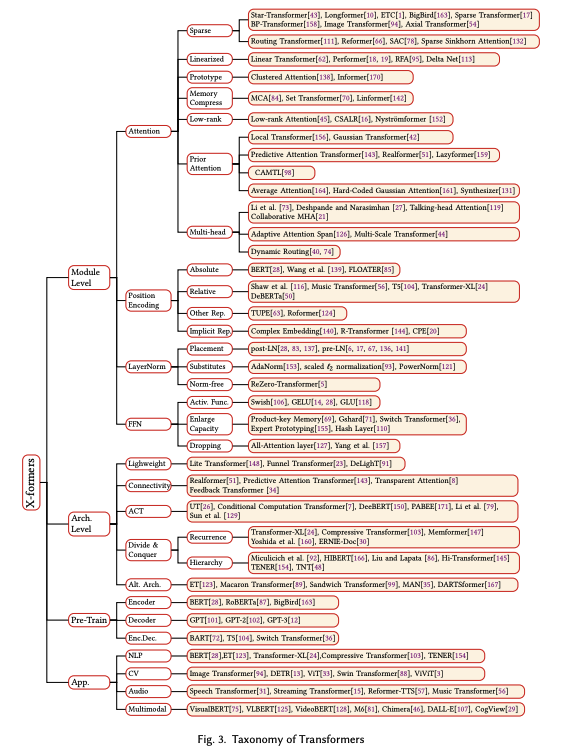

from Hacker News https://ift.tt/OC9sivN
No comments:
Post a Comment
Note: Only a member of this blog may post a comment.